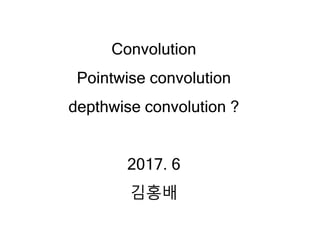Convolution 종류 설명
•Transferir como PPTX, PDF•
11 gostaram•10,367 visualizações
홍
홍배 김Xception, MobileNets등에서 활용되는 pointwise(1x1)convolution, depthwise convolution에 대한 설명
Denunciar
Compartilhar
Denunciar
Compartilhar

Recomendados
Recomendados
Slides by Amaia Salvador at the UPC Computer Vision Reading Group.
Source document on GDocs with clickable links:
https://docs.google.com/presentation/d/1jDTyKTNfZBfMl8OHANZJaYxsXTqGCHMVeMeBe5o1EL0/edit?usp=sharing
Based on the original work:
Ren, Shaoqing, Kaiming He, Ross Girshick, and Jian Sun. "Faster R-CNN: Towards real-time object detection with region proposal networks." In Advances in Neural Information Processing Systems, pp. 91-99. 2015.Faster R-CNN: Towards real-time object detection with region proposal network...

Faster R-CNN: Towards real-time object detection with region proposal network...Universitat Politècnica de Catalunya
Mais conteúdo relacionado
Mais procurados
Slides by Amaia Salvador at the UPC Computer Vision Reading Group.
Source document on GDocs with clickable links:
https://docs.google.com/presentation/d/1jDTyKTNfZBfMl8OHANZJaYxsXTqGCHMVeMeBe5o1EL0/edit?usp=sharing
Based on the original work:
Ren, Shaoqing, Kaiming He, Ross Girshick, and Jian Sun. "Faster R-CNN: Towards real-time object detection with region proposal networks." In Advances in Neural Information Processing Systems, pp. 91-99. 2015.Faster R-CNN: Towards real-time object detection with region proposal network...

Faster R-CNN: Towards real-time object detection with region proposal network...Universitat Politècnica de Catalunya
Mais procurados (20)
Patch SVDD: Patch-level SVDD for Anomaly Detection and Segmentation

Patch SVDD: Patch-level SVDD for Anomaly Detection and Segmentation
Deep Learning: Recurrent Neural Network (Chapter 10) 

Deep Learning: Recurrent Neural Network (Chapter 10)
Artificial Neural Networks Lect5: Multi-Layer Perceptron & Backpropagation

Artificial Neural Networks Lect5: Multi-Layer Perceptron & Backpropagation
Faster R-CNN: Towards real-time object detection with region proposal network...

Faster R-CNN: Towards real-time object detection with region proposal network...
Intelligent networks, camel_services_and_applications_v1

Intelligent networks, camel_services_and_applications_v1
Destaque
Destaque (16)
InfoGAN: Interpretable Representation Learning by Information Maximizing Gene...

InfoGAN: Interpretable Representation Learning by Information Maximizing Gene...
Knowing when to look : Adaptive Attention via A Visual Sentinel for Image Cap...

Knowing when to look : Adaptive Attention via A Visual Sentinel for Image Cap...
Explanation on Tensorflow example -Deep mnist for expert

Explanation on Tensorflow example -Deep mnist for expert
Meta-Learning with Memory Augmented Neural Networks

Meta-Learning with Memory Augmented Neural Networks
Single Shot MultiBox Detector와 Recurrent Instance Segmentation

Single Shot MultiBox Detector와 Recurrent Instance Segmentation
Mais de 홍배 김
Mais de 홍배 김 (16)
Automatic Gain Tuning based on Gaussian Process Global Optimization (= Bayesi...

Automatic Gain Tuning based on Gaussian Process Global Optimization (= Bayesi...
Learning agile and dynamic motor skills for legged robots

Learning agile and dynamic motor skills for legged robots
Anomaly Detection and Localization Using GAN and One-Class Classifier

Anomaly Detection and Localization Using GAN and One-Class Classifier
ARCHITECTURAL CONDITIONING FOR DISENTANGLEMENT OF OBJECT IDENTITY AND POSTURE...

ARCHITECTURAL CONDITIONING FOR DISENTANGLEMENT OF OBJECT IDENTITY AND POSTURE...
Convolution 종류 설명
- 1. Convolution Pointwise convolution depthwise convolution ? 2017. 6 김홍배
- 2. 최근 Xception, MobileNtes등에서 사용되는 다양한 convolution 기술 중 일반적인 convolution, Pointwise convolution (1x1 convolution)과 depthwise convolution의 차이는 ? 목적 : CNN의 계산량 및 매개변수 수를 줄임으로써 Xception은 큰 이미지 인식의 고속화 MobileNets은 정도를 유지하면서 Networks의 경량화
- 3. Pointwise convolution과 depthwise convolution의 장점을 이해하기 위해, 우선 일반 convolution의 계산량 및 parameter 수에 대해 생각해보면 어떤 CNN에 대한 입력 특징 맵의 크기를 FxF, 입력 채널 수를 N, 커널 크기를 KxK, 출력 채널 수를 M으로 하면, 이 CNN의 계산량은 F2NK2M이 된다.
- 4. 이것은 입력 특징 맵 1개당 Convolution의 cost가 K2N으로 이를 입력 특징 맵 F2 개에 적용해서 1 채널의 출력 특성 맵이 생성되기 때문에, 출력 특징 맵이 M개 경우에는 위의 계산과 같다. parameter 수가 K2N의 Convolution이 M종류이기 때문에, K2NM이 된다.
- 5. Pointwise convolution Pointwise convolution은 ResNet등의 skip connection에도 이용되는 1x1 convolution이다. 공간 방향의 convolution은 실시하지 않고, 채널 방향에만 convolution을 한다. 특징 맵의 차원을 늘리거나 줄일 때 이용된다. Pointwise convolution은 일반 convolution에서 K = 1로 한 것이기 때문에, 계산량은 F2NM, parameter 수는 NM이 된다.
- 6. Depthwise convolution Depthwise convolution는 특징맵 채널마다 각각 공간 방향의 convolution 을 수행한다. 채널 방향에 convolution을 수행하지 않기 때문에 일반 convolution 1회의 cost가 K2N에서 K2로 되므로 CNN의 계산량은 F2NK2, parameter 수는 K2N이 된다.
- 7. 일반적인 convolution이 특징 맵의 공간 방향 및 채널 방향으로 동시에 convolution 을 실 시 하 는 반 면 , 채 널 방 향 의 convolution(pointwise convolution)과 공간 방향의 convolution (depthwise convolution)을 분리 (factorize)해서 따로 계산한 후 후에 합쳐서 적용하여 공간 방향 및 채널 방 향을 동시에 convolution하는 convolution보다 적은 parameter 및 계산량으 로 근사 할 수있다. 계산량은 F2NK2M에서 F2NM + F2NK2로 감소된다. 비율로 말하면, 1/K2 + 1/M으로 되므로, 통상 M >> K2(e.g. K = 3, M≥32)이므 로, 계산량은 1/9 정도로 감소됨